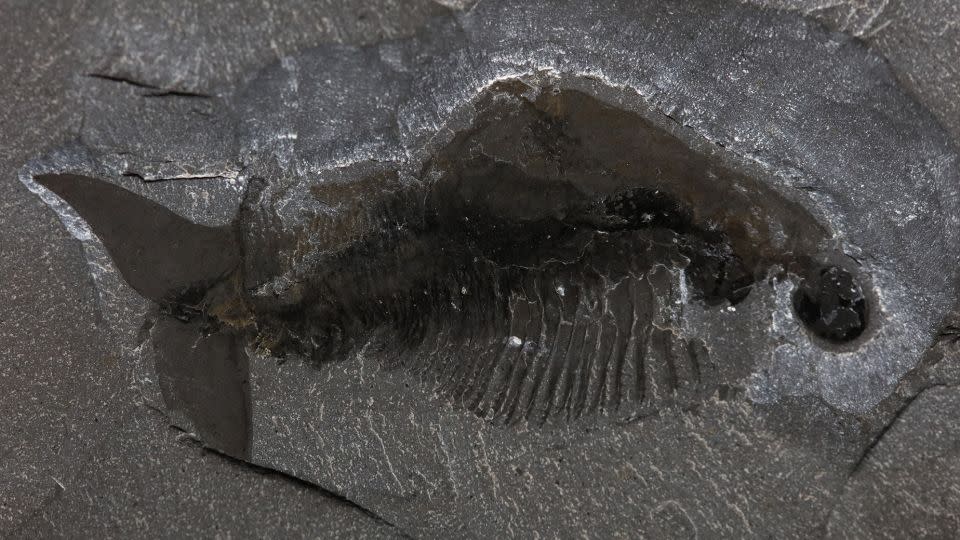Sign up for CNN’s Wonder Theory science newsletter. Explore the universe with news on fascinating discoveries, scientific advancements and more.
An ancient buglike sea creature with a fan-shaped tail and a carapace that wrapped around its body swam upside down and looked like a taco — but this taco could bite back.
Newfound fossils of the extinct arthropod Odaraia alata recently provided scientists with a first glimpse of Odaraia’s jawlike structures, called mandibles. These small, paired appendages near the mouth bite, hold and tear food, and arthropods with these mouthparts are called mandibulates.
The first mandibulates evolved in oceans during the Cambrian period (541 million to 485.4 million years ago) and include modern crustaceans, insects and myriapods, such as centipedes and millipedes. Whether snipping, ripping or gripping, mandibles help arthropods get the job done, and mandibulates diversified so successfully that today they make up more than half of all animal species, according to the Royal Ontario Museum.
Identifying mandibles in Odaraia resolves a long-standing mystery about how the creature captured its meals, and suggests that Odaraia sits among the earliest mandibulates in the arthropod family tree, researchers reported July 24 in the journal Proceedings of the Royal Society B: Biological Sciences.
The species was described in 1912 from fossils found at the Burgess Shale in British Columbia, Canada, in rocks dating back to around 505 million years ago. However, the heads of these fossils were incomplete. This left scientists uncertain of whether Odaraia belonged among mandibulates, as head appendages are critical for classifying extinct arthropods, said lead study author Alejandro Izquierdo-López. He conducted the research at the Royal Ontario Museum while pursuing a doctoral degree in the University of Toronto’s department of ecology and evolutionary biology.
For the new investigation, the researchers examined around 150 fossils collected by Royal Ontario Museum during expeditions between 1975 and 2000. Most of the specimens were new material that had not previously appeared in scientific publications, Izquierdo-López said.
“Only a couple had been published before,” he said in an email. “We had clear mandibles in a little bit more than 10, which shows how difficult it is to find them preserved!”


The preserved mandibles were previously only hinted at by muscle scars in other Odaraia specimens, the study authors reported. Odaraia’s newfound mouthparts “are stout, short appendages with a row of teeth,” Izquierdo-López added. “This is exactly what we would expect a mandible to look like.”
Their discovery underscores that even for known species, new fossils can still be full of surprises, said Dr. Joanna Wolfe, a research associate in the department of organismic and evolutionary biology at Harvard University.
“Revisiting species that we know from before is important. In this case, they (the study authors) had a lot of new material,” Wolfe said. “Sometimes features are only visible on one specimen, so you should always look.”
Prey-catching leg hairs
Odaraia measured about 6 inches (15 centimeters) long and peered at its ocean home through large eyes on stalks. Its body was divided into dozens of segments, with more than 30 pairs of spindly legs.
Encasing it was the so-called taco shell — a tubular shield that folded around Odaraia’s body, leaving its head sticking out the front and its tail poking from the back. Many arthropods have this taco-like feature, known as a bivalve carapace, “including living arthropods like ostracods (seed shrimp) and fan shrimps,” Wolfe said.
The carapace folded over Odaraia’s limbs, so it may have been unable to walk on the seafloor, according to the Royal Ontario Museum. Instead, the sea-bug taco likely got around as modern horseshoe crabs do: by swimming upside down.


While its legs may not have been used for walking, they were probably important for snaring food such as smaller Cambrian sea creatures, the researchers reported. When they examined the fossils, they found stiff, hairlike structures called setae lining the animals’ legs. These tiny spines could have trapped food, much as rows of baleen in whales’ mouths filter seawater and trap plankton.
“We think that the spines could interlock between the legs, creating a net that would capture passing prey,” Izquierdo-López said.
This type of feeding is common among many modern crustaceans, which have different types and lengths of setae that they use for food capture, Wolfe added.
More mandibulate mysteries
One feature that puzzled and intrigued the scientists had never been seen before in Cambrian animals: a single toothlike structure between Odaraia’s mandibles.
“We still don’t know what it is, exactly, even when comparing it to mandibulates today,” Izquierdo-López said. “We think, though, that it was probably used together with the mandibles to chew the food further. This structure may have evolved into other similar ones in centipedes or in crabs, but we cannot say more, to date.”
Finding additional fossils could clarify the function of this structure, and may help to flesh out other unusual details about Odaraia, such as the existence of three small eyes between the two bigger ones. Prior studies briefly described these light-sensitive organs, though the researchers did not detect the rudimentary eyes in their scans.
“We could not see those three eyes very well in this study, but we cannot reject their presence completely,” Izquierdo-López said. “Future specimens may uncover an even more complex head than we have today.”
Mindy Weisberger is a science writer and media producer whose work has appeared in Live Science, Scientific American and How It Works magazine.
For more CNN news and newsletters create an account at CNN.com
